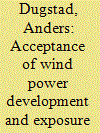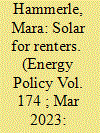|
|
|
Sort Order |
|
|
|
Items / Page
|
|
|
|
|
|
|
| Srl | Item |
| 1 |
ID:
177143


|
|
|
|
|
| Summary/Abstract |
Despite a large stated-preference (SP) literature on wind power externalities, few SP studies employ a case-control approach to examine whether people's acceptance of new wind power developments and renewable energy initiatives increases or decreases with exposure. Furthermore, the existing studies are inconclusive on this issue. In a case-control discrete choice experiment, we measure the level of acceptance in terms of people's willingness-to-accept (WTA) for having future land-based wind power developments in Norway; comparing exposed and non-exposed people's WTA. We find that exposure lowers acceptance. Furthermore, exposed people are also unwilling to pay as much to increase general domestic renewable energy production (from all sources) as non-exposed people, and thus have lower acceptance for such renewable energy policy initiatives. After testing for type of exposure, we argue that the inconclusiveness in the literature of how exposure affects acceptance of wind power developments could be due to the fact that impacts considered differ somewhat across studies.
|
|
|
|
|
|
|
|
|
|
|
|
|
|
|
|
| 2 |
ID:
125748


|
|
|
|
|
| Publication |
2013.
|
| Summary/Abstract |
This paper investigates how Korean government support affects household adoption of renewable energy-based micro-generation systems by analyzing household preferences in relation to the costs and benefits of system installation and different kinds of government support. The research adopts a discrete choice experiment approach and focuses on two micro-generation technologies: solar voltaic and solar thermal. Our empirical analysis revealed firstly that households prefer micro-generation systems that have low installation costs but high energy saving benefits and long warranty periods; and secondly that households prefer direct subsidies to low-interest loans. However, we also found that households are reluctant to install photovoltaic or solar thermal systems in reality because they see the cost of system installation as being higher than the benefits they would receive from such installation. In short, while existing government supports are somewhat effective in promoting household adoption of micro-generation systems, there also exists the obstacle that the majority of households are unwilling to install such systems despite government support. Thus several policy improvements, which focus on increasing the benefits and decreasing the installation costs of micro-generation systems, are suggested in this paper.
|
|
|
|
|
|
|
|
|
|
|
|
|
|
|
|
| 3 |
ID:
116760


|
|
|
|
|
| Publication |
2012.
|
| Summary/Abstract |
In this paper we estimate the willingness to pay for mix of renewable sources of electric power by means of a discrete choice experiment survey conducted in Spain in 2010. Two main categories of power supply attributes are explored: source of renewable power (wind, solar and biomass) and the origin of such power. The findings suggest that most consumers are not willing to pay a premium for increases in the shares of renewable in their electricity mix. For two of the three renewable sources considered (wind and biomass) an increase of the renewable mix would require a discount. Instead, we record positive willing to pay for increases in the share of both solar power and locally generated power. However, preferences for types of renewable (solar and wind) are found to be heterogeneous. By classifying respondents in two groups according to the implied importance of the share of renewable sources in their power mix we identify a market segment consisting of 20% of respondents that could promote renewable energy in the absence of subsidies. This is because such a segment shows willingness to pay higher than the current feed-in tariffs.
|
|
|
|
|
|
|
|
|
|
|
|
|
|
|
|
| 4 |
ID:
175892


|
|
|
|
|
| Summary/Abstract |
Rural residential space heating is strongly linked to policy considerations related to the clean energy supply and rural sustainable development. As there has been a hot debate on whether to promote district heating in South China, this paper aims to investigate household heating choices with a particular focus on rural residential sector, using the survey data from Sichuan Province. In order to investigate the main influencing factors of household decision-making behaviors, a multinomial logit (MNL) model with sample selection correction and an alternative-specific conditional logit (ASCL) model were used to respectively analyze the actual and stated choices. The estimation results show that energy-specific attributes such as safety level and smoky level have statistically significant effects on household stated preferences for heating systems. Households prefer to adopt lower-cost heating system with high quality energy sources. Among household-specific characteristics, income level, educational level of the decision-maker, household demographic structure, and household location are important determinants of heating fuel choices. These findings suggest that future energy policy should pay more attention to its combined effect on both cost and quality of heating system as well as its different regional effects. Besides, enhancing household socio-economic status should also be attached importance in policy design.
|
|
|
|
|
|
|
|
|
|
|
|
|
|
|
|
| 5 |
ID:
186473


|
|
|
|
|
| Summary/Abstract |
The development of Renewable Energies (RE) must be stepped up in the coming years if we are to successfully realise the ambitious energy transition challenge set by many governments across the globe. However, the energy transition is far from obvious, especially with regard to the social acceptability of RE. In this context, we used a Discrete Choice Experiment combined with a Geographical Information System to assess the willingness of individuals to switch to a more virtuous energy mix based on three energy sources (wind, photovoltaic and biogas). Our results show a dominant generational effect, indicating that young people are more likely to accept renewable energy in their neighborhoods. Furthermore, residents in areas with renewable energy with negative externalities (wind turbines and anaerobic digestion units) tend to have a lower Willingness to Pay than residents in other areas, which is what we call the principle of territorial distributive justice. There is no reason to believe that the difficulties in finding new locations for RE installations could fade away. Therefore, an increased effort of public policies to plan the location of future RE facilities in a more equitable way and always a better explanation and co-construction of new RE projects are needed.
|
|
|
|
|
|
|
|
|
|
|
|
|
|
|
|
| 6 |
ID:
181778


|
|
|
|
|
| Summary/Abstract |
Many countries, states, and territories have set short and long term targets to increase the share of renewable sources for electricity generation as part of their respective energy policies. Increased reliance on renewables can occur from several sources (e.g., biomass, solar, hydro, wind). Similarly, when increasing renewables, a decreased reliance on one or more non-renewable (e.g., coal, gas, oil, nuclear) sources must occur. However, each region is different with respect to its present profile and capabilities to generate electricity. Complicating this is that demand can differ across individuals, states and territories. By using a discrete choice experiment and latent class hybrid choice model (LCHCM), we estimate individual willingness to pay (WTP) values among four renewable and four non-renewable energy sources for residents across Australia’s states and territories. The model identifies two latent segments in relation to WTP, which can be described using differences in pro-environmental attitudes and socio-demographics. The findings reveal that preferences in terms of energy mix composition for electricity generation are heterogeneous across Australia states and individuals. WTP is found to be higher for biomass, whilst those who are younger, males and those holding pro-environmental attitudes are also supportive of hydro and solar over gas and nuclear sources.
|
|
|
|
|
|
|
|
|
|
|
|
|
|
|
|
| 7 |
ID:
171396


|
|
|
|
|
| Summary/Abstract |
Winter peaks in Belgian electricity demand are significantly higher than the summer peaks, creating a greater potential for imbalances between demand and supply. This potential is exacerbated because of the risk of outages in its ageing nuclear power plants, which are being phased out in the medium term. This paper conducts a choice experiment to investigate the acceptability of a load control-based demand response program in the winter months. It surveys 186 respondents on their willingness to accept limits on the use of home appliances in return for a compensation. Results indicate that respondents are most affected by the days of the week that their appliance usage would be curtailed, and by the compensation they would receive. The willingness to enroll in a program increases with age, environmental consciousness, home ownership, and lower privacy concerns. The analysis predicts that 95% of the sample surveyed could enroll in a daily load control program for a compensation of €41 per household per year. Thus while an initial rollout among older and more pro-environment homeowners could be successful, a wider implementation would require an explanation of its environmental and financial benefits to the population, and a greater consideration of their data privacy concerns.
|
|
|
|
|
|
|
|
|
|
|
|
|
|
|
|
| 8 |
ID:
191251


|
|
|
|
|
| Summary/Abstract |
Rooftop solar photovoltaic (PV) systems present households with a way to reduce their energy bills, while contributing to a clean energy transition. However, rental properties are considerably less likely to have solar PV. It is unclear whether current policies that focus on reducing upfront costs to installing solar PV address the barriers perceived as most important by property investors. Using a best-worst scaling survey of 931 property investors, we find that investors on average view renters being unwilling to pay higher rents for properties with solar PV equally as important as affordability concerns as barriers to investment. Owners of apartments or townhouses focus on structural barriers. Our discrete choice experiment of 147 property investors shows that policies that spread solar system payments over time and direct feed-in tariff revenue to property investors are not preferred by most owners of fully-detached rental dwellings. We conclude by stressing the importance of policies that reduce information asymmetries from the property investor perspective regarding the value that renters place on PV systems. There is also a need for policies to better address barriers faced by owners of apartments and townhouses.
|
|
|
|
|
|
|
|
|
|
|
|
|
|
|
|
| 9 |
ID:
180112


|
|
|
|
|
| Summary/Abstract |
Given the important role that electricity plays in powering society, and the significant risk that extreme weather and other events pose in disrupting electricity supply, the idea of community-scale microgrids has come to the forefront to enhance electrical grid resiliency and provide critical services to local communities during extended outages. In this paper, a discrete choice experiment is used to evaluate willingness to pay (WTP) for services provided by a community microgrid during extended power outages. With a sample of 939 respondents from New York State, results indicate that, overall, there is a positive willingness to pay for microgrid services, including hospital and emergency services, potable water, shelters, and retail outlets; even if residents are not receiving their own residential electricity supply during an outage. The average willingness to pay for the full suite of evaluated microgrid services is approximately $14 per month per household. We also find that WTP varies with some sociodemographic and other characteristics. These results provide critical evidence for rate-makers and utilities in evaluating societal benefit when making investment decisions for microgrids and related infrastructure.
|
|
|
|
|
|
|
|
|
|
|
|
|
|
|
|
|
|
|
|
|